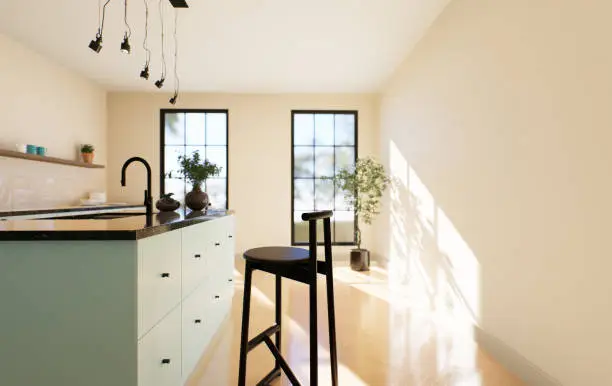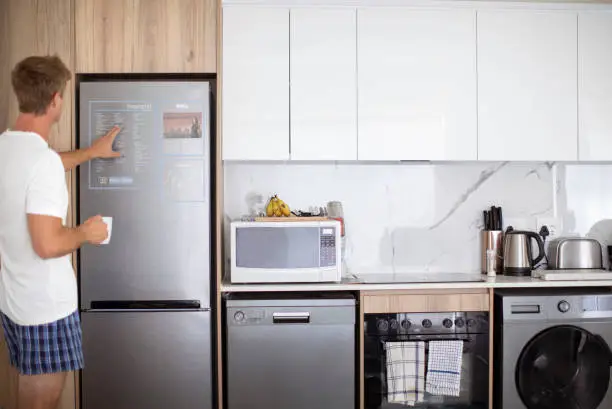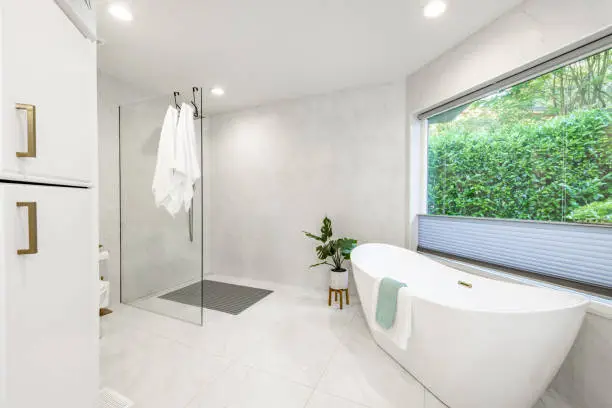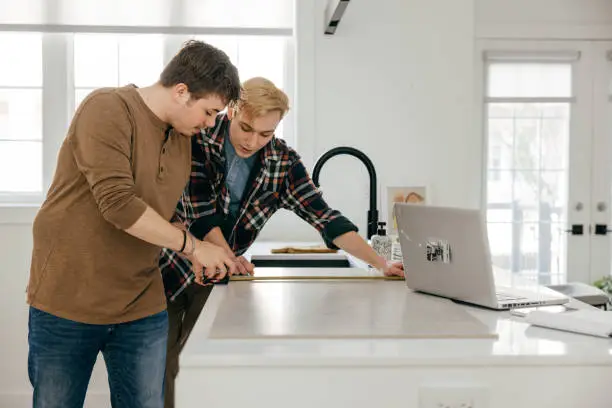Neurodiversity remodeling involves the active construction of kitchens and bathrooms that reduce sensory overload and support a wide range of needs. Through the choice of silent appliances, the use of calming color schemes and addition of materials that are tactilely pleasant, all-inclusive remodeling can promote a healthier and more comfortable living and residence to everyone.
Understanding the Needs of Neurodiverse Individuals in Home Design

Neurodiversity design starts with an understanding of how the built environment appeals to the senses. Special attention should be paid to kitchens and bathrooms in particular, since, in contrast to other areas, they produce strong auditory, visual, tactile, and spatial demands and established routines. Remodelers can create healthier home environments by examining the most common triggers and making conscious decisions about the materials and spatial layout of space, which can benefit the health of all residents. These adjustments create independence and meet the physical and emotional needs of all occupants.
What Is Neurodiversity and Why It Matters in Remodeling
Neurodiversity is the innate variations in human cognition, including autism, ADHD, and sensory processing disorder. These differences affect the way people perceive and relate to the immediate environment. Once a home is redesigned to fit neurodiversity, the daily activities are easier to perform but comfort is not sacrificed. An organized design can reduce stress, bring structure, and promote independence.
Common Sensory Triggers in Kitchens and Bathrooms
A kitchen or a bathroom can be unsettling due to its harsh lighting, chilly tiles, offending noise, and visual chaos, all of which can continue daily distress. The aspects of sensory-friendly remodeling can reduce anxiety, create a feeling of independence, and make the space more usable to all residents. Such stressors are easier to recognize at the design stage, to be able to develop more targeted and successful interventions.
Common Sensory Triggers Table:
| Trigger Type | Common Source | Suggested Solution |
|---|---|---|
| Visual | Overhead fluorescents, high-gloss tiles | Use dimmable warm LEDs, matte surfaces |
| Auditory | Loud fans, clanging dishes, echoing tile | Add soft-close features, sound-absorbing mats |
| Tactile | Cold or slick floors | Use cork, textured vinyl, or non-slip tiles |
Sensory-Friendly Kitchen Remodeling Ideas

The design of a kitchen that can offer sensory comfort requires consideration of the acoustic factors, light, and surfaces that are friendly to the touch. This kind of approach provides a space that is both calm, functional, and aesthetically pleasing, thus creating an environment whereby all residents can feel comfortable. The subsequent alterations also increase safety and accessibility of neurodiversity persons and the entire household.
Soft Lighting and Reduced Glare Surface Options
Soft lighting that is mounted on the ceiling is much better suited to neurodiversity peoples. Hard direct light should be avoided in favor of soft diffused light; reflective surfaces must be kept to a minimum. This change will make cooking, eating and socializing in the kitchen a lot more comfortable and less demanding. Having colour schemes in common and using multiple layers of light, one will gain more control over visual stimulation.
Tips for Light and Surface Adjustments:
-
Use matte-finish cabinets and counters to reduce glare
-
Install task lighting with dimmable settings
-
Avoid high-contrast patterns that cause visual confusion
Quiet Appliances and Touch-Sensitive Controls
Appliances with low-decibel ratings and intuitive controls are essential. Quiet dishwashers, low-hum refrigerators, and motion-sensor faucets can all reduce stress and simplify kitchen tasks. Integrating technology that responds to touch or motion also adds ease and hygiene.
Sensory-Friendly Kitchen Upgrades:
-
Soft-close drawers and cabinets to reduce sudden noises
-
Induction cooktops that heat quietly and safely
-
Touchless faucets for easy, hygienic use
Bathroom Renovation Strategies for Sensory Balance

Bathrooms are often acoustically resonant, hard-surfaced, and temperature- and light-sensitive in nature. In the case of sensory regulation improvement of such space, it is possible to promote non-violent routine and support safer self-care. In addition, an overstimulation that may be experienced through bathing and grooming activities is lessened in a sensory-aware bathroom.
Non-Slip, Warm-Textured Flooring and Calm Color Schemes
Cold, reflective tile may be too stimulating; hence, it is best to choose a floor that feels warm to walk on and use colors that promote calmness. Soft fabrics and similar color shades reduce visual clutter and create a calm environment. Neurodiversity in people generally look good in muted blues, earthy colors, and pastels.
Best Flooring Options:
-
Cork (soft, warm, and antimicrobial)
-
Rubber or textured vinyl (non-slip and quiet)
-
Matte porcelain tiles (safe and easy to clean)
Temperature-Regulating Fixtures and Smart Lighting Systems
The rapid changes in temperature surrounding area and the bright light in the bathroom may be disturbing. This can be reduced by using thermostatic control, smart mirrors with adjustable lighting and fans that detect the level of humidity. The possibility of tailoring the bathroom environment to suit the needs of different users over shorter time intervals becomes possible with such technological solutions.
Smart Bathroom Features Table:
| Feature | Benefit |
|---|---|
| Thermostatic shower valves | Consistent water temperature |
| Smart mirrors | Adjustable brightness, defogging |
| Motion-sensor lights | Reduce overstimulation from sudden brightness |
Collaborating With Remodel Contractors on Inclusive Designs

It is essential to enlist the services of effective remodel contractors to design neurodiverse-friendly kitchens and bathrooms. Communication and careful planning ensure that the result meets the sensory and aesthetic needs. Experienced contractors, also, are able to suggest technologies and materials that were not necessarily considered at the first glance.
Communicating Sensory Needs and Functional Priorities
It is generally a good idea to describe individual preferences related to the physical setting, whether it is a preference towards soft textures, relaxed lighting, or subtle color schemes. You can state the reasoning behind these choices by providing illustrative evidence, describing the specific triggers, and walking your contractor through an overview of your everyday life. The practice makes the planning process more efficient and effective.
Incorporating Flexible Spaces and Adjustable Features
Multi-functional, flexible designs are essential in addressing the varied sensory needs and promoting independence. The flexibility of using space by adapting it to the needs of the users is possible due to modular shelving systems, mobile partitions, and foldable work surfaces. These characteristics make a remodeling project develop in line with the emerging needs of the family.
Flexible Features to Request:
-
Pull-out shelves to reduce physical strain
-
Adjustable-height counters or vanities
-
Color-coded zones to improve orientation and clarity
Benefits of Inclusive Remodeling for the Entire Household

Sensory-friendly design is a practice that benefits neurodiversity in people and the general population. Silent home appliances, increased lighting, and designs that guarantee accessibility translate into quantifiable value, functionality and durability of any remodeling project. These adaptations help to instill a more peaceful and regular pace to all the residents and tourists.
Enhancing Daily Routines with Thoughtful Layouts
Routine is facilitated by a commitment to designing features most evident in the smooth transitions, soft lighting, and well-defined zones. This kind of consistency is especially helpful to children or those who have ADHD and thrive in predictable environments. It also upholds a clean and orderly living space.
Universal Design That Adds Value and Comfort
Inclusive design is a practice that has a natural resilience. Adaptable lighting, wider doorways, and ergonomic fixtures will always be useful as family circumstances change, and these features benefit everyone who lives in a house thus increasing both the long-term value and livability of a home. In this regard, the strategy is a wise expenditure on comfort, accessibility, and resale value.
Frequently Asked Questions (FAQs)
1. What are the best design choices for sensory-sensitive individuals?
A prudent attitude to architecture requires a number of prominent steps: the careful use of matte surfaces to reduce glare; the selection of appliances that produce low levels of noise; the use of soft or adjustable lighting and the use of natural materials, e.g. cork or rubber flooring. Similarly, the spatial order should also be simple and clearly defined in order to prevent visual disorientation and psychological fatigue. Together with the tailored features, such as calming color schemes and touchable materials, all these features contribute greatly to daily livability.
2. How do I make my kitchen or bathroom more autism-friendly?
The first step is to reduce the stimulus overload: put in soft-close mechanisms, select quieter appliances, and use soothing color schemes. Get rid of loud patterns, and provide intelligent lighting, which allows accurate adjustment of brightness. Creating different areas of specific tasks will help in organization of routines and autonomy. Be attentive to temperature changes and choose the materials that spread a comfortable, homelike atmosphere.
3. Are there professionals who specialize in neurodiversity remodeling?
Most remodel contractors have the knowledge of universal design or have proven to be skilled in the creation of sensory friendly spaces. A good practice when choosing a provider is to ask about certifications in accessibility or aging-in-place remodeling, as these certifications often coincide with neurodiversity design factors. Moreover, it is recommended to get the examples of former work and references of happy clients.
4. Can inclusive design still look stylish and modern?
Indeed. The sensory-friendly design can be easily integrated into the modern aesthetics of clean lines, muted colors, and natural textures. In addition, much of the accessible design, such as ergonomic layouts, and intelligent lighting, are becoming more upscale and trendier. Function and beauty must not be opposites.
5. Does remodeling for neurodiversity affect the resale value of a home?
Inclusive design is normally an added value to the resale value of a property, as more and more potential buyers are currently focusing on comfort and accessibility. Soundproofing of appliances, smart lights, and anti-slippery flooring are among the upgrades that have unanimous support and makes a house more appealing to a wider range of customers. In addition, these enhancements can be used to future-proof a home to age in place.
Looking to find a kitchen or bathroom remodel that takes into consideration neurodiversity and comfort in terms of senses? KBR Kitchen & Bath specializes in all-inclusive, serene settings that combine beauty with functionality. Through the balancing of illumination, acoustic management, and universal spatial planning, our experienced remodel professionals ensure the experience that is specific to your needs is achieved. Visit our Fairfax, Bethesda (Kitchen), Bethesda (Bathroom), or Manassas showrooms or call us now to set up an appointment.

